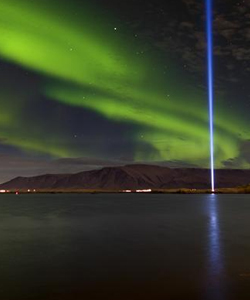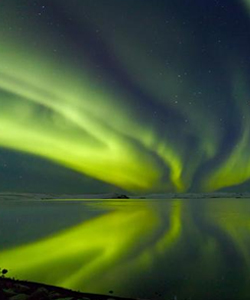
Northern Lights
It comes as no surprise that our ancestors at the sight of multicoloured lights
dancing silently across the nightly sky took them for the erring souls of their
dead (the Inuit) or traces of the gods playing football with walrus skulls (the
Vikings – no kidding). Creative and admittedly also a bit weird but definitely more
charming explanations than the (dry) scientific one we have today.

Northern Lights: What is it?

Responsible for the nightly light show is the sun, or rather the electric particles
it keeps sending towards the earth. The earth is surrounded by a magnetic field
running more or less parallel to the earth's surface and bending towards it towards
the poles. Incoming solar particles are deviated along it, „sliding“ on the curved
magnetic field towards the poles where they enter the atmosphere and collide with
“local” particles. The bent shape of the magnetic field is the reason why Northern
Lights are only to be seen in the very North and South of our planet.
The hit local particles are being lifted up into a higher state of activation. They
loose the energy almost immediately again which becomes visible in form of light.
There we are.
The colour of the (northern) light depends on the type of particle hit. The most
common one is oxygen giving of a green (sometimes reddish) light. On rare occasions
yellow and blue colours can be seen.
The quantity of particles emitted by the sun varies, from day to day, from year
to year. The sun passes through an “activity cycle” lasting 22 years,11 years it's
on the rise, another 11 on the decline.
The best news: 2013 is the peak in the current solar cycle, meaning that the chances
to witness spectacular Northern Lights this year and also the following are very
high!

Southern Lights
Although Northern Lights (Latin: Aurora Borealis) has become a synonym for the Auroras
in general the phenomenon occurs on either one of the two hemispheres. In the South
we call them Aurora Australis. The greater popularity of the first has mostly “infrastructural”
reasons: it is way easier to get close to the North than to the South Pole.
Around the South Pole is Antarctica. And then for a long time: nothing. The next
landmass (South Australia or South America) is approx. 6.000 km away, a lot farther
than the northern parts of Canada and Europe are from the North Pole. Cape North
in Norway for example lies at only about 2.000 km from the pole (Reykjavik still
at a short 2.886 km). To appreciate some decent Southern Lights you would have to
catch a plane or embark on a (cruise) ship heading for Antarctica.

When and where can I see Auroras best?
We get the answer to those questions applying what we learned above :-)
Where?

The closer to the (North) pole the better. Obviously, you think. But only partly
true.
The pole you want to be close to is the magnetic and not the geographic one. Not
only that the two poles don't coincide geographically, the magnetic pole is a geographic
gipsy: it moves.
As you can see on the picture it had ventured from the open Atlantic Ocean into
Canadian territory and back again during the course of the centuries, currently
heading further north.
If that wasn't already kind of an unacceptable behaviour for such an important physical
factor it sometimes even occurs to him to switch places with its southerly brother.
Sounds like a SciFi-movie but it's true: the North Pole becomes the South Pole and
vice versa. This has happened as many as 25 (!) times in the history of earth, the
last time approx. 720.000 years ago. It will happen again. Some time. But at the
end of the day does it matter if the light show above is Aurora Borealis or (an
erratic) Australis?
What we learn from the above described is: the strength of the Auroras is greater
in Iceland (and Greenland) than it is in the more easterly parts of Scandinavia.
But no matter where you are on Earth: try to get away from (artificial) lights!
Big cities are not the best spot for Northern Light's watching. Out on the countryside!
And up the mountain! Star observatories are placed on mountain tops for a reason.

When?
Particles from the sun come flying towards the earth regardless of the time of year
or day, that's to say also during day time and in the summer. Only then the light
makes it impossible for us to see them. What we thus need most of all is: darkness.
Since darkness is a rare summer phenomenon in regions north of the Arctic Circle
the best light watching period is the time of year it is getting dark at night.
Obviously, you say, okay. But this is not necessarily only winter time. In Iceland
it is getting dark from as early as the middle of August (summer!) and continues
to do so until the beginning of April (spring).
That cold temperatures facilitate the creation of Northern Lights is a myth. It
derives probably from the fact that temperatures in winter (=dark time = best spotting
time) are very low and drop even more on clear nights.
Clear skies on the other hand are one of the most important factors in the whole
matter. And the hardest one to predict.
The later the night the higher the possibility to see Auroras is by the way just
another of the many Aurora myths (where's the physical explanation?).
Let's assume the gods are favourable, there are no clouds in sight, above us nothing
but black skies with its millions of stars. If there are going to be Auroras and
how strong they will be now only depends on – you know it! - right: the solar wind,
that's to say the amount of particles that is hitting the magnetic field. This is
– as amazing as it seems – predictable (!), well, not for the very moment you look
up but in terms of the date: yes.
Solar activity is constantly measured by meteorological institutes around the globe.
Since it takes the sun's particles approx. two days to make the distance sun–Earth
the strength of the solar winds (= the intensity of the Aurora) can be predicted
for at least this time span with surprising accuracy. The Aurora forecast of the
Geophysical Institute of the University of Alaska (for Iceland and all other regions)
can be found at: http://www.gi.alaska.edu/AuroraForecast.
To give you an idea: a 3 on the scale is already pretty good. On a 5 day you should
definitely grab a lot of warm cloths and several thermoses to prepare for a long
night out. The 10 on the scale is more hypothetically (probably meaning the sun
exploding...).
The Geophysical Institute by the way also offers an Aurora Alert. Subscribers receive
an email whenever the solar activity is at it's peak.
We have some trips especially designed for Aurora hunters. [link]